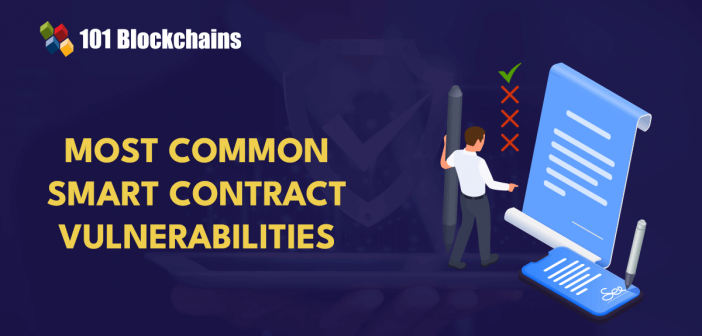Learn how blockchain truly works, master key definitions, and uncover what makes smart contracts so "smart." Dive into the fundamentals, gain valuable insights, and start your blockchain journey today!

- Solidity & Smart Contracts
Georgia Weston
- on February 29, 2024
Most Common Smart Contract Vulnerabilities And How to Mitigate Them
Smart contracts are an essential component for ensuring decentralized and automatic execution of transactions on blockchain networks. It primarily deals with transactions involving financial assets. On the other hand, it is important to know that common smart contract vulnerabilities could lead to big losses. As a matter of fact, smart contract vulnerabilities have been responsible for financial losses measuring over $12.3 billion. For example, the DODO DEX lost almost $3.8 million in March 2022 to a smart contract vulnerability. In April 2023, one of the popular DeFi platforms, Yearn Finance, lost $10 million due to smart contract flaws.
Smart contracts are responsible for transactions involving massive volumes of important data and assets, such as money transfers, service delivery, and access to protected content. As a result, they can be easy targets for hackers and other malicious actors. On the other hand, awareness of smart contract vulnerabilities could offer the opportunity to prepare for smart contract attacks. Let us learn more about some of the most common vulnerabilities of smart contracts and how you can resolve them.
Excited to learn about the critical vulnerabilities and security risks in smart contract development, Enroll now in the Smart Contracts Security Course
Popular Vulnerabilities for Smart Contracts and Mitigation Strategies
Security is one of the foremost priorities in the process of designing and developing smart contracts. The different types of smart contract attacks in recent times and their magnitude imply that smart contract security is a mandatory requirement for new blockchain and web3 solutions. On top of that, you could not make any changes in the smart contracts once they have been deployed to blockchain networks with different vulnerabilities.
Most important of all, the vulnerabilities of smart contracts are visible to everyone after they have been deployed on blockchain networks. Therefore, development teams and smart contract engineers must pay attention to the most important attack vectors for smart contracts. Here is an outline of the most common vulnerabilities in smart contracts and the strategies for mitigating them.
-
Oracle Manipulation
One of the prominent entries among vulnerabilities for smart contracts is Oracle manipulation. Smart contracts rely on oracles for accessing external data from sources outside the blockchain network. However, oracles can be responsible for smart contract security issues as malicious actors could manipulate oracles to achieve personal interests.
Oracles help smart contracts interact with off-chain systems. On the other hand, manipulated or inaccurate Oracle data could enable automatic execution of smart contracts. Such types of issues are classified as Oracle issues for smart contracts. The Oracle issue has been responsible for exploitation of different DeFi applications.
The most common example of such problems with smart contracts is visible in the flash loan attacks. Flash loans allow users to borrow any amount of cryptocurrency without any limit as long as they repay the loan in the same transaction. Attackers can use such loans to distort asset prices and generate profits without compromising the principles of blockchain technology.
You can find solutions to the Oracle issue for smart contracts with decentralized oracles, such as Tellor or Chainlink. Another recommended mitigation strategy for such risks points to the use of multiple oracles. Decentralized oracles or multiple oracles for one smart contract ensure accuracy of input data for the oracle. Such types of oracles increase the difficulty and cost of manipulating oracle data.
-
Denial of Service
The most noticeable example of web2 attacks that have transitioned into the domain of web3 is denial of service. Smart contracts are also vulnerable to denial of service attacks. It is one of the common entries in a smart contract vulnerabilities list, which can create setbacks for users and reputation of web3 projects. The attack involves overloading a smart contract with services, such as authentication tasks.
As a result, the attacker could prevent other contracts from execution and lead to unexpected reverts. For example, denial of service attacks can return unused gas and revert the state of the smart contract to the state prior to execution of the transaction. Subsequently, the attacker could find that the results of an auction or values in financial transactions can be manipulated easily.
The promising approach to solving such types of smart contract attacks focuses on making the attacks costly. What are the proven ways to improve the cost of denial of service attacks for hackers? Higher gas fees and time-lock puzzles are some of the effective measures for increasing the costs of attackers. In addition, mitigation strategies for denial of service attacks also focus on making calls only to trusted contracts.
-
Timestamp Dependence
The collection of different types of vulnerabilities for smart contracts also includes timestamp dependence. It is important to note that the node executing the smart contract generates timestamp values. How does the timestamp lead to smart contract vulnerabilities, and what is their impact? The distributed nature of Ethereum creates difficulties in synchronization of time on every node. Since Ethereum is the preferred platform for developing and deploying smart contracts, it exacerbates the timestamp dependence issue.
Malicious nodes could manipulate the timestamp value for designing a logic attack. The logic attack would target contracts that utilize the block timestamp variable for execution of time-critical operations. You can resolve such vulnerabilities by avoiding the use of block timestamp function for control or logic checks. It is also important to refrain from using block timestamp function as a source of randomness.
Curious to understand the complete smart contract development lifecycle? Enroll now in the Smart Contracts Development Course
-
Reentrancy Attacks
Another common vulnerability in smart contracts is a reentrancy attack. The attack vector emerges from the imperative execution of Solidity smart contracts. Imperative execution implies that smart contracts must execute each line of code before the next line. It implies that the execution of the calling contract can be put on hold till the return of the call when the contract makes external calls to a different contract. Reentrancy attacks are one of the common additions to a smart contract vulnerabilities list, as the external contract could gain temporary control over the next sequence of events. As a result, reentrancy attacks lead to the creation of an infinite loop.
Assume that a malicious contract attempts a recursive call to the original contract to withdraw resources without completion of the first call. As a result, the original contract would never have the opportunity to update the balance before completing the function. The smart contract security issues with reentrancy could take the form of multiple types of attacks. Some of the common types of reentrancy attacks include single-function, read-only, cross-function, and cross-contract reentrancy attacks.
You can resolve problems with reentrancy attacks through careful design of external calls. It is important to note that such vulnerabilities arise from flaws in the code logic of smart contracts. Therefore, it is important to check and ensure updates on the state of the contract.
In addition, you can also find another proven safeguard against reentrancy attacks with a reentrancy guard. Reentrancy guards could prevent the execution of multiple functions at one instance by locking the contract. You can rely on smart contract audit tools such as Mythril and Slither for checking the presence of different variants of reentrancy attacks.
Want to know about the possible use cases of smart contract audits? Check out Smart Contract Audit Presentation now!
-
Frontrunning Attacks
Smart contracts are transparent, which implies that they are publicly visible on the blockchain network. Miners of a block could choose transactions with the highest gas fees. The priority fee is an effective tool for ensuring that you can have your transaction approved before other transactions.
However, it also leads to problems with smart contracts as attackers could front-run the profitable contracts through submission of an identical contract, albeit with a higher gas fee. Generally, attackers implement frontrunning attacks through bots or even miners.
You have to look for effective solutions to mitigate the risks of frontrunning attacks. One of the proven solutions for mitigating the risks of frontrunning involves accepting transactions that have the gas price below a specific threshold. You can also find a solution with a commit-and-reveal scheme in which users submit a solution hash first rather than a clear text solution. Malicious actors cannot view the solution before it is too late. At the same time, smart contract auditing tools can help in detecting frontrunning vulnerabilities.
-
Integer Overflows and Underflows
Arithmetic operations also play a role in creating vulnerabilities for smart contracts. Integer overflows and underflows are the most common smart contract vulnerabilities resulting from arithmetic operations surpassing the fixed range for the values. For the integer type uint8, the range of values spans from 0 to 255.
If the values are higher than 255, then they would overflow, and the value would be reset to 0. On the other hand, values that are lower than 0 would be reset to 255. As a result, the state variables of the contract and the logic could go through unexpected modifications and could trigger invalid operations.
The Solidity compiler, starting from version 0.8.0, would not allow code that could lead to integer overflows and underflows. It is also important to check the contracts that could be compiled with the earlier versions to support functions that involve a library or use arithmetic operations.
-
Information and Function Exposure
Blockchain technology enables better accessibility for every individual. Sensitive and confidential information must be encrypted before they are saved to a blockchain network. However, transparency leads to different types of smart contract attacks due to visibility of functions and variables in smart contracts. As a result, the functions and variables would be open to abuse and misuse. You can find a solution to such issues with improvements in development workflow.
Developers must ensure the implementation of proper access controls. In addition, developers must also implement the principle of least privilege with the help of variable and function visibility modifiers in Solidity. The modifiers help in assigning minimum visibility levels according to the desired requirements.
-
Force-Feeding Attacks
The next prominent cause for smart contract security issues points to the problems with force-feeding attacks. Developers could not prevent smart contracts from receiving the native cryptocurrency of Ethereum, Ether. Malicious actors could utilize this vulnerability for force-feeding smart contracts with Ether.
The attack revolves around the premise of manipulating the balance of Ether in the smart contract. The change in balance of Ether could lead to manipulation of function logic that depends only on desired balance for internal accounting. Some of the internal accounting processes include paying out rewards when the balance exceeds a specific level.
The problem with such smart contract vulnerabilities is that it is difficult to stop the manipulation of smart contract balance. Therefore, it is important to ensure that the balance of the contract does not serve as a guard or check within a function. The actual balance of the Ether could be higher than the balance expected by the internal code of the contract.
-
Gas Griefing
Another prominent addition to the smart contract vulnerabilities list is gas griefing. Users should pay a gas fee for performing a transaction or executing smart contract on Ethereum blockchain. It serves as an incentive for the validators or miners to verify transactions. On the other hand, the price of gas depends on network capacity, supply, and demand at the time of transaction.
Gas griefing happens when users send the gas fees required for executing the desired smart contract. However, they don’t send the fees required for executing subcalls or the calls made by the contract to other contracts. It would lead to a significant influence on the logic of the smart contract.
The problem is that there is no proven technique for preventing gas griefing. Developers could find a solution by coding a contract for defining the amount of gas rather than the user. Such types of solutions are more likely to increase the chances of transaction failure.
Start learning Smart Contracts and its development tools with world’s first Smart Contracts Skill Path with quality resources tailored by industry experts now!
Final Words
The review of the different smart contract vulnerabilities and mitigation strategies shows that awareness could solve a lot of problems. You should understand the importance of smart contracts in managing valuable data and resources. Flaws in smart contracts could lead to security issues that impose the burden of financial losses.
Therefore, smart contract developers must prepare an effective risk management strategy and smart contract audit plan for identifying vulnerabilities. Learn more about smart contract fundamentals to obtain a first-hand impression of the potential sources of vulnerabilities in smart contracts.
*Disclaimer: The article should not be taken as, and is not intended to provide any investment advice. Claims made in this article do not constitute investment advice and should not be taken as such. 101 Blockchains shall not be responsible for any loss sustained by any person who relies on this article. Do your own research!







